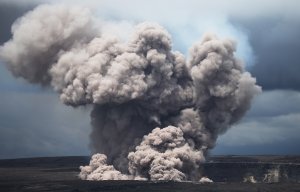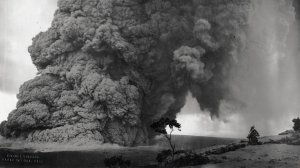Hawaii’s Kilauea volcano appears to be mimicking behavior last seen in 1924, when it morphed from producing slow-moving lava to spitting up columns of ash and tons of rock that landed more than half a mile away.
Geologists on Wednesday warned that the rapid lowering of a lava lake in a crater has raised the potential for explosions in coming weeks.

If the lava drops to the level of cooler groundwater, the influx could cause steam-driven explosions.
And if that’s not enough to get weary Big Island residents’ attention, agencies say such explosions “provide very little warning.”
The US Geological Survey’s Hawaiian Volcano Observatory said the crater would emit “ballistic projectiles” — as small as pebbles or weighing up to several tons.
“At this time, we cannot say with certainty how large the explosions could be. In 1924 blocks were thrown up to 0.6 miles from the vent and pebble-sized rocks several miles away. Ash could fall much father downwind,” the USGS tweeted.
A camera run by the Hawaiian Volcano Observatory and located on the south rim of Halemaʻumaʻu — the largest crater on Kilauea — is continually taking images of the active lava lake. Thermal imagery, above, shows the fast drop in the lake level.
Scientists say explosive eruptions occur when magma — or molten rock — drops below the water table. The groundwater interacts with the hot rock, and steam pressure builds and can cause explosions.
In 1924, ash may have reached as high as 20,000 feet above sea level. That came during nearly three weeks of activity.

Blocks weighing as much as 14 tons were blasted from the crater, littering the landscape and making for numerous photos of gawkers standing next to boulders. One person was killed by falling debris. Little evidence of the debris remains today.
Halema’uma’u doubled in diameter and deepened and did not hold a lava lake again until 2009, says the USGS, adding the 1924 explosions were small potatoes compared to previous events, such as in 1790.
The current lava lake draining makes Kilauea ripe for another series of blasts.
Volcanologist Erik Klemetti wrote Wednesday that Kilauea may be moving past its “usual playbook.”
“Scientists at (the Hawaiian Volcano Observatory) have their work cut out for them right now, with the ongoing eruption at Leilani Estates still producing new fissures and now the potential that the summit might produce something more explosive,” he wrote in his blog.
Klemetti and agencies noted that no one knows for sure what will happen.
“At this time, we cannot say with certainty that explosive activity will occur, how large the explosions could be, or how long such explosive activity could continue,” an advisory said.





















